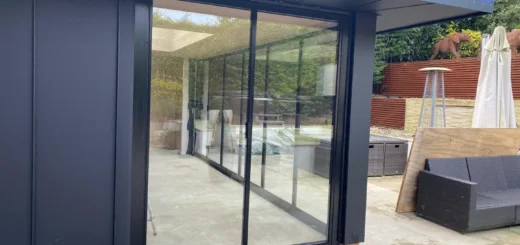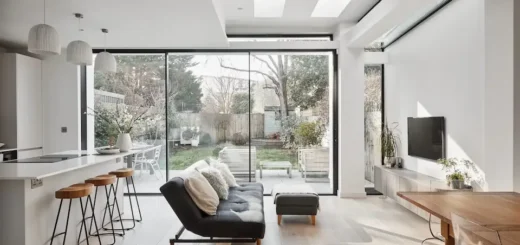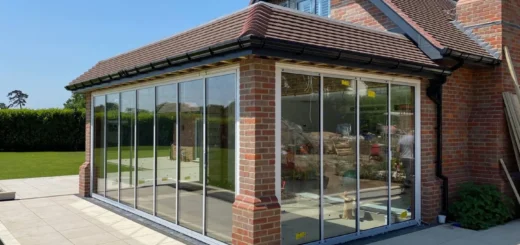Grey Bifold Doors: Design & Styling Guide
Table of Contents
Types of Grey Bifold Doors
Grey bifold doors have surged in popularity across British homes, with shades ranging from soft dove grey to deep charcoal tones.
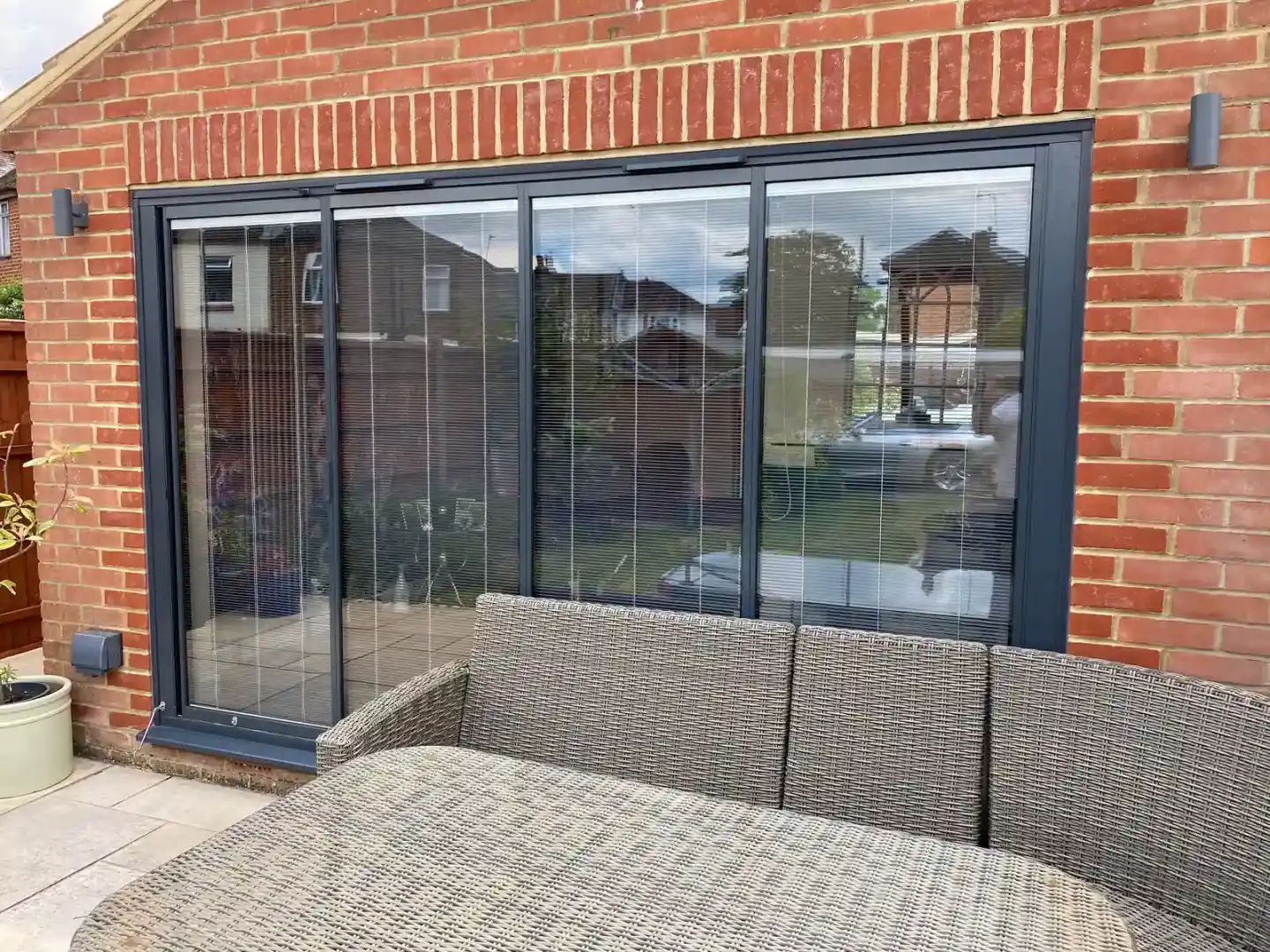
Anthracite Grey vs Slate Grey
Deep and rich, anthracite bifold doors bring a bold modern look that draws attention while staying subtle enough to suit most architectural styles. The blue-grey undertones in anthracite create depth and character, particularly in spaces with abundant natural light.
Slate grey offers a softer alternative, with warmer undertones that blend beautifully with both contemporary and traditional surroundings.
Natural light plays a big part in how these grey shades appear. Morning sun brings out slate grey’s warmer notes, while anthracite maintains its depth regardless of lighting conditions. Under artificial lighting, dark grey bifold doors take on different personalities – halogen bulbs highlight their metallic qualities, while LED lighting can make them appear softer and more matte.
RAL Colour Guide for Grey Doors
RAL codes provide precise colour matching for grey bifold doors, helping you pick exactly the right shade. RAL 7016 defines the popular anthracite grey, while RAL 7015 captures slate grey’s distinctive tone. Light grey bifold doors often use RAL 7035, producing a bright, fresh look that works well in smaller spaces.
Paint manufacturers use these standardised codes to ensure consistent results across different materials and finishes. When you’re comparing samples, morning daylight gives the truest representation of how the colour will look in your space.
Textured Grey Finishes
Modern powder coating techniques produce bi-folding doors with varied surface textures that add visual interest beyond the colour itself. Matt finishes reduce glare and hide fingerprints effectively, while gloss coatings create striking reflections that catch natural as well as artificial light. Textured powder coating combines durability with a tactile surface that masks minor scratches.
Different finishes change how the grey shade of grey appears – matt coatings often make colours look darker and more intense, while gloss finishes can lighten the apparent shade. Surface texture also changes how light moves across the doors, creating subtle variations in tone throughout the day.
Surface Protection
Powder coated aluminium doors resist scratching and fading better than wet-painted alternatives. The thick, durable coating maintains its appearance even in challenging coastal environments where salt air can damage less robust finishes. Pre-treatment processes prepare the aluminium surface properly, ensuring the powder coating bonds strongly and provides lasting protection.
Grey Bifold Doors in Modern Extensions
Modern kitchen extensions demand doors that bring in plenty of natural light while maintaining clean architectural lines. Grey bifold doors pair particularly well with the pared-back style of contemporary extensions, creating a sophisticated connection to outdoor spaces.
Light vs Dark Grey in Extensions
The amount of natural light your extension receives should guide your choice of grey shade. North-facing rooms often benefit from light grey bifold doors that reflect available light back into the space. South-facing extensions can handle darker greys without looking gloomy – the strong directional light brings out subtle variations in deeper shades.
Morning and evening sun strike doors at different angles, changing how the colour appears. A narrower bifold door configuration might need a lighter shade to avoid looking heavy, while wider openings can carry off darker tones. Custom bifold doors let you specify the exact shade to match your extension’s unique lighting conditions.
Matching Interior Design Styles
Minimalist design principles work exceptionally well with grey folding doors – their clean lines and unfussy appearance support rather than compete with the surrounding space. Industrial-style extensions favour deeper greys that complement exposed brick and concrete surfaces, while Scandinavian-inspired spaces often pair better with warmer grey tones.
Grey bifolding doors serve as an excellent backdrop for different design styles, from ultra-modern to soft industrial. Their neutral nature allows bold furniture choices to stand out while maintaining visual harmony. Kitchen islands and worktops in contrasting materials – whether marble, wood, or composite – create interesting interplay against the doors’ surface.
Metal fixtures and handles deserve careful attention when planning your extension’s overall look. Brushed steel hardware on grey bifold doors adds subtle detail, while black handles make a stronger statement. Copper or brass fittings bring warmth to cooler grey shades, preventing the space from feeling too stark.
Lighting Design
Strategic placement of light fixtures can highlight the texture and colour of your doors. Wall-mounted downlights cast interesting shadows across textured grey surfaces, while hidden LED strips can outline the door frames after dark. Natural shadows from trees or pergolas create ever-changing patterns across the surface throughout the day.
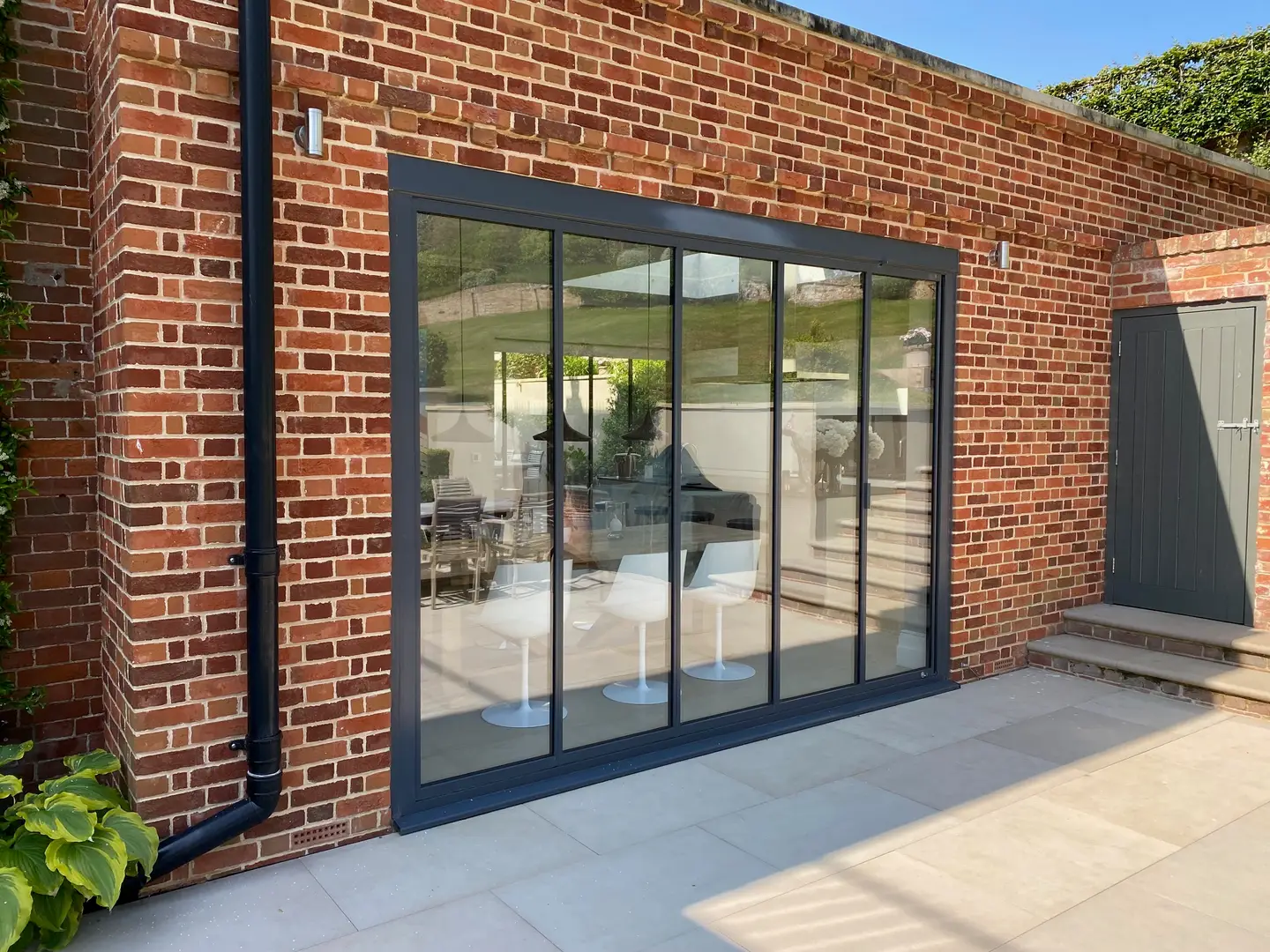
Statement or Subtle
Some homeowners choose grey concertina doors as a subtle frame for garden views, while others make them a focal point through contrasting surroundings. Light-coloured walls make darker grey doors pop forward visually, creating drama. Matching wall and door colours produces a more understated effect, letting other design elements take centre stage.
Window treatments need careful planning – blinds or curtains should complement rather than fight with the doors’ appearance. Sheer fabrics soften the hard lines of the frames while maintaining privacy. Motorised blinds tucked into ceiling recesses keep the clean looks intact when privacy is needed.
The proportions of your extension influence how prominent the doors should be. Larger spaces can handle bold, dark greys that might overwhelm smaller rooms. The relationship between ceiling height and door height matters too – taller doors draw the eye upward, making spaces feel more generous.
Wall finishes near the doors merit special attention. Polished plaster picks up light differently from standard paint, creating subtle contrast with powder-coated door surfaces. Textured wallpapers bring visual interest without competing with the doors’ clean lines. Paint colours should work with your chosen grey rather than matching it exactly – slight variations in tone create more visual interest than perfect matches.
Styling Your Grey Bifold Doors
Grey bifold doors provide a neutral foundation that supports many different interior and exterior schemes. The right styling choices can make these doors a striking architectural feature or a subtle backdrop.
Interior Colour Schemes
Wall colours need careful selection to work with grey bi-fold doors. Whites and creams offer a classic pairing that keeps spaces bright and airy. Deep blues and greens create sophisticated colour combinations, while earthy tones like terracotta bring warmth to counterbalance cool greys.
Flooring materials play an essential part in the overall look. Natural wood adds warmth – oak’s golden tones particularly complement cooler greys, while darker woods like walnut create rich contrasts. Stone or porcelain tiles in similar grey tones to the doors make spaces feel larger, as the eye flows uninterrupted across the surfaces.
Soft furnishings offer opportunities to add layers of interest. Textured fabrics like bouclé or wool bring tactile warmth, while patterns incorporating grey frames tie the whole scheme together. Metallic accents in cushions or artwork catch the light similarly to powder-coated door surfaces, creating visual connections throughout the space.
Choosing Hardware
Bifold doors require thoughtfully chosen handles and hinges that complement the door colour. Black hardware creates sharp definition against lighter greys, while stainless steel offers a more subtle detail. The hardware finish should match other metallic elements in the room for a cohesive appearance.
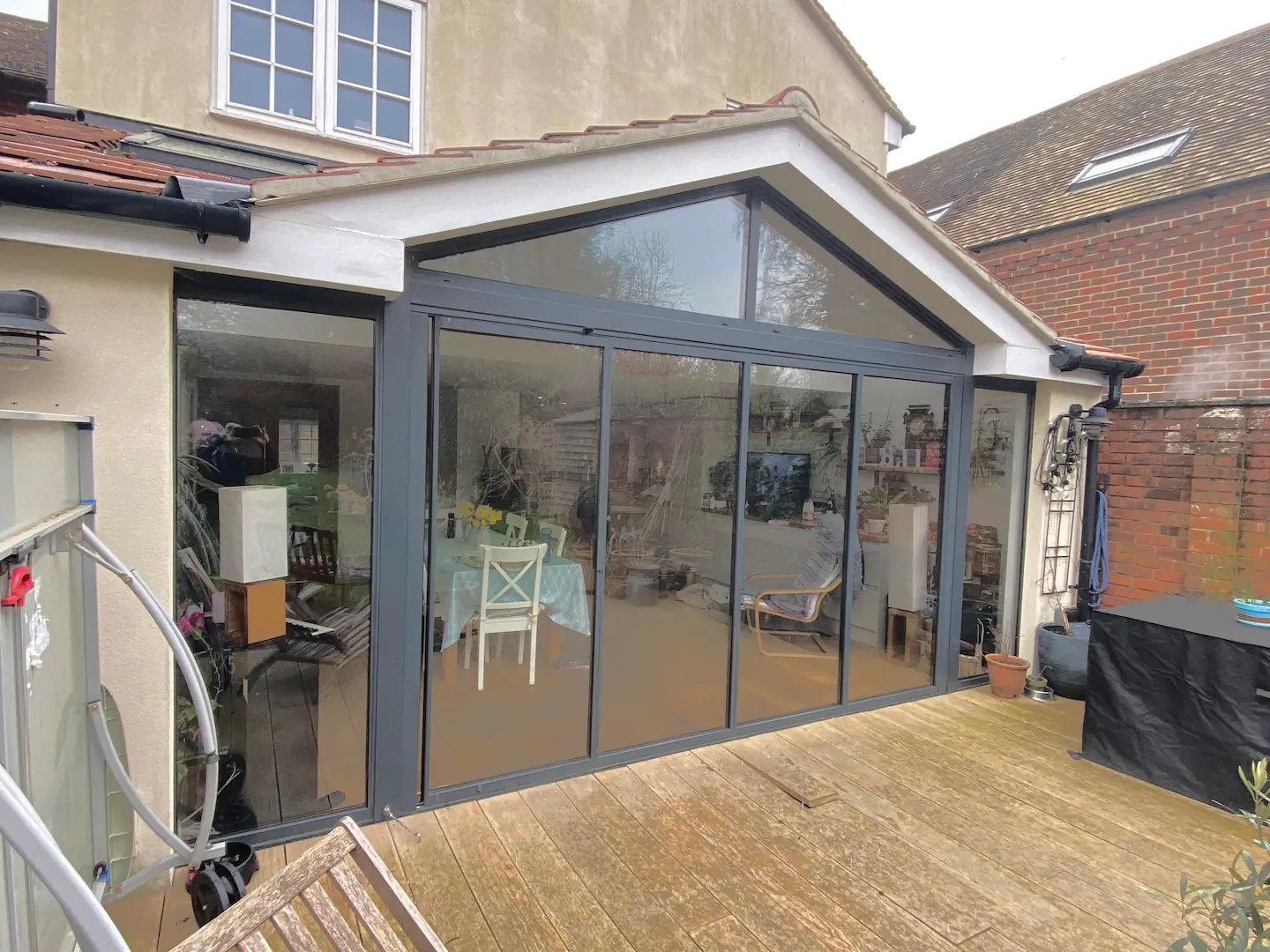
External Finishes
Grey folding doors look particularly striking against pale render or natural stone. Red brick provides a classic contrast that suits period properties, while contemporary timber cladding creates an architectural statement.
The shade of grey chosen for the doors should work with existing materials rather than fighting against them.
Garden design directly influences how grey bifold doors look from outside. Green planting provides a soft contrast to the doors’ crisp lines. Hardscaping materials like slate or granite can echo the doors’ colour, creating visual harmony between house and garden.
Grey concertina doors often become a focal point of the garden view. Carefully positioned outdoor furniture can draw attention to the doors without cluttering the immediate area. Garden lighting techniques like uplighting or spotlights make grey surfaces stand out more after dark.
Lighting Choices
Natural light interacts differently with various grey shades throughout the day. South-facing grey bifold doors might benefit from integral blinds to manage strong sunlight. These blinds, fitted between the glass panes, maintain clean lines while offering practical light control.
Artificial lighting needs planning to avoid unwanted reflections on glass panels. Wall lights positioned either side of the doors provide ambient illumination without glare. Strip lighting concealed in the door frame creates subtle highlights that outline the opening after dark.
The popular choice of pendant lights over kitchen islands or dining tables near bifold doors requires careful positioning. Lights hung too close to the doors can create distracting reflections, while properly placed fittings improve the space’s appearance at night.
Light levels in adjoining rooms deserve attention when planning artificial lighting. Sudden changes in brightness between spaces can make doors appear darker than they are. Layered lighting using a mix of ceiling, wall, and floor-level sources helps maintain balanced light levels as natural light fades.
Window treatments for adjacent windows should coordinate with the doors’ style. Simple roller blinds in matching grey tones maintain architectural simplicity, while curtains in contrasting fabrics add softness to the scheme. The treatment style should suit the room’s purpose – kitchens might need practical blinds while living spaces can handle more decorative options.
Grey Bifold Doors for Period Properties
Period homes present unique opportunities for incorporating modern elements while respecting original architectural features. Grey bifold doors can bridge old and new styles when chosen with sensitivity to the building’s character.
Heritage Colour Selection
Victorian and Edwardian properties often feature strong architectural details that work surprisingly well with grey folding doors. Deeper greys echo traditional lead and iron work, while softer tones complement stone features and original brickwork. Powder-coated finish options allow precise matching to existing period metalwork.
The era of your property guides appropriate colour choices. Georgian homes suit lighter, more classical greys that match Portland stone or painted timber. Victorian properties can handle darker, more industrial tones that reference their manufacturing heritage. Arts and Crafts houses often work best with warmer greys that complement their characteristic natural materials.
Grey bifolding doors need careful proportioning in period settings. Breaking up large expanses of glass with narrower panels helps maintain scale with original windows. Narrow bifold doors often suit older properties better, as their proportions echo traditional French doors or sash windows.
Period-Appropriate Hardware
Door furniture should reflect your home’s age. Bronze or aged brass handles add authenticity to Victorian-style grey bifold doors, while chrome suits Art Deco properties. The hardware’s shape matters as much as its finish – ornate designs suit grander properties, while simpler styles work better in modest period homes.
Traditional Interior Matching
Original features near grey concertina doors deserve special attention. Cornices and ceiling roses take on new prominence against modern door frames. Picture rails can define the height of wall colours, creating subtle breaks that work with new door openings.
Period fireplaces provide natural focal points that can balance grey aluminium frames. Marble surrounds particularly suit cooler greys, while wooden mantels work beautifully with warmer tones. Original tiles often contain hints of grey that can guide door colour selection.
Wooden floors in period properties require thoughtful coordination with modern doors. Original floorboards can be restored to provide warming contrast to cool greys. Parquet patterns draw the eye inward, making the doors feel like a natural extension of the interior scheme.
Wall coverings typical of different periods can work harmoniously with modern grey bifold doors. William Morris-style patterns incorporate grey tones that tie in with contemporary door finishes. Traditional damask designs gain fresh relevance when paired with clean-lined door frames.
Stained glass features common in Victorian and Edwardian homes create interesting interplay with modern glazing. Original coloured glass casts changing patterns across grey door surfaces throughout the day. New doors can incorporate textured or opaque glass panels that reference period glazing patterns.
Many period properties have complex room layouts that modern extensions aim to improve. Grey bifold doors can mark the point where old meets new without jarring. Changes in floor level between original rooms and extensions need careful handling – door thresholds can bridge different heights while maintaining visual flow.
Ceiling heights in period properties often differ from modern standards. Taller rooms can accommodate larger door panels without looking overwhelmed. Door frame proportions should relate to ceiling height, window positions, and other architectural elements to maintain visual harmony.
Original brick or stonework revealed during renovation provides opportunities for striking contrasts. Exposed materials can frame grey door openings, creating a dialogue between old and new. The texture of aged materials adds depth and interest to modern door installations.
The Technical Side of Grey Bifold Doors
The performance and longevity of grey bifolds depend heavily on their materials, manufacturing processes, and installation methods. Materials science and production techniques have advanced substantially in recent years.
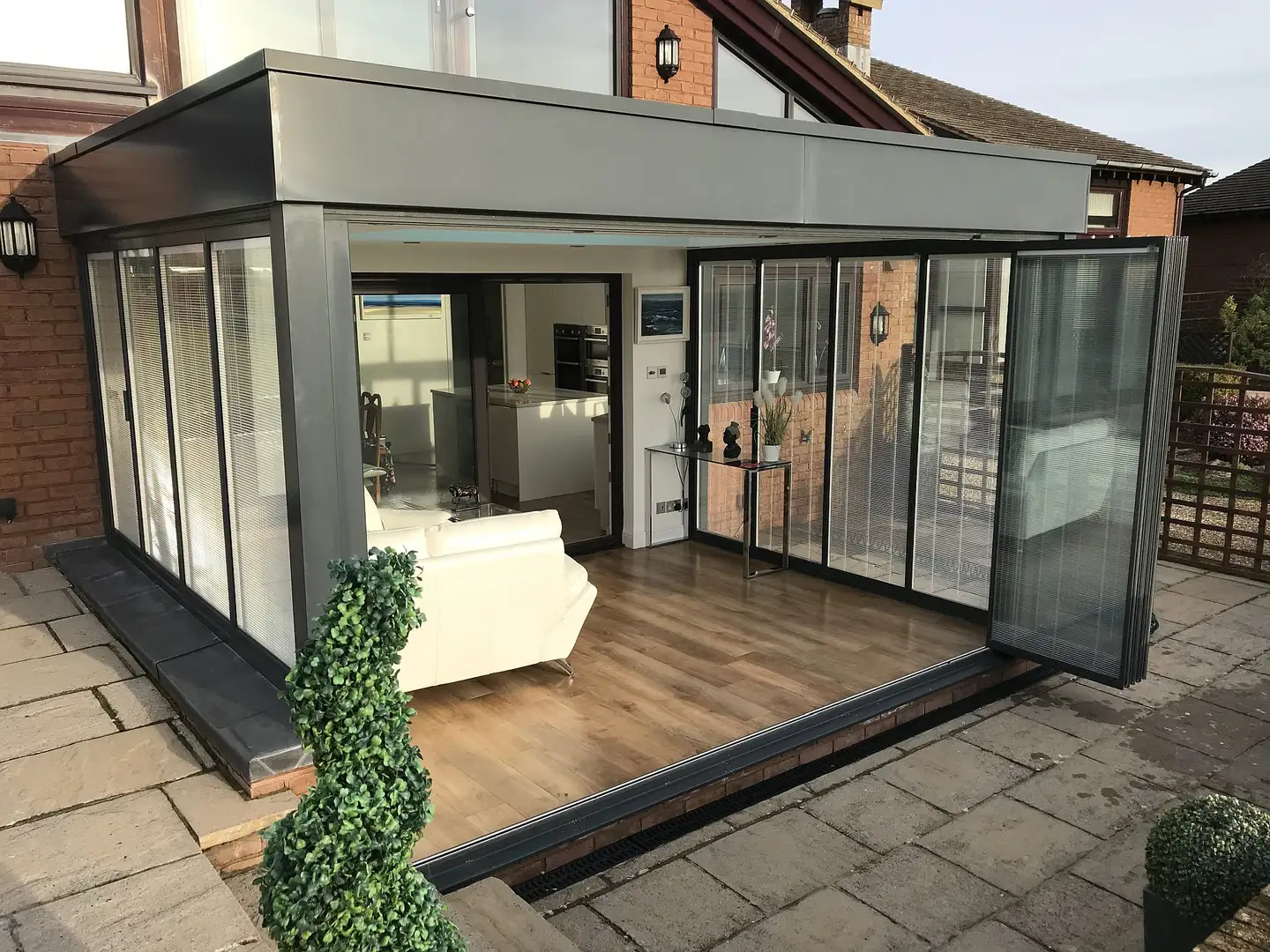
Finish Durability
Modern powder coating creates exceptionally tough surfaces on grey aluminium bifold doors. The coating process involves electrostatically charging paint particles, which stick evenly to the metal surface before heat curing. This method produces a harder, more durable finish than liquid paint systems.
UV exposure poses a particular challenge for grey bi fold doors – cheaper finishes can fade or discolour over time. High-quality powder coatings contain special UV-resistant pigments that maintain their appearance for years. The coating thickness matters too – professional finishes measure at least 60 microns deep for lasting protection.
Salt air in coastal areas can speed up wear on metal surfaces. Marine-grade powder coatings provide extra protection for grey folding doors in seaside locations. These specialised finishes include additional pre-treatments and thicker coating layers that resist corrosion more effectively.
Surface Treatment
Pre-treatment processes fundamentally shape how well coatings stick to aluminium. Chromate conversion coatings create a microscopically rough surface that helps paint grip better. Modern chrome-free alternatives offer similar benefits while meeting stricter environmental standards.
Frame Materials
Grey bifold doors manufactured from thermally-broken aluminium provide better insulation than standard metal frames. The thermal break – a strip of less conductive material between inner and outer frame sections – reduces heat transfer through the metal. This design helps prevent condensation forming on interior surfaces during cold weather.
The aluminium alloy choice makes a real difference to door performance. Architectural-grade alloys resist warping and maintain smooth operation even with frequent use. These materials cost more than standard grades but provide better long-term value through improved stability and durability.
Low threshold bifold doors need particularly robust frame materials to support their weight while allowing easy access. The reduced step height places extra stress on bottom tracks and rollers. High-grade aluminium alloys handle these loads without deforming, keeping operation smooth over years of use.
Thermal Performance
Glazing options for grey concertina doors have expanded beyond standard double glazing. Triple glazing improves insulation but adds weight – frames need proper reinforcement to carry the extra load. Low-iron glass reduces the slight green tint seen in standard glass, showing the true grey colour of frames more accurately.
Glass coating technology has improved hugely. Modern low-emissivity coatings reflect heat while letting light through, improving the energy efficiency of grey aluminium doors. Solar control glass options reduce overheating in south-facing rooms without darkening the glass noticeably.
The space between glass panes contributes substantially to insulation performance. Argon gas filling improves thermal efficiency compared to air-filled units. The spacer bars separating glass panes used to create noticeable cold spots, but modern ‘warm edge’ spacers reduce this effect while complementing grey frame finishes.
Gasket materials need careful selection to maintain weather protection without compromising aesthetics. EPDM rubber compounds resist UV damage better than cheaper materials, staying flexible and effective longer. Well-designed gasket profiles prevent water ingress while remaining hidden from view, maintaining clean lines around glass panels.
Operating mechanisms in grey bifold doors require precision to work smoothly. Running gear materials affect long-term performance – stainless steel wheels and tracks last longer than plain steel versions. Self-lubricating bushings in hinges and rollers reduce maintenance needs while keeping operation quiet.
Channel drainage systems built into door tracks need proper design to handle heavy rain. Concealed drainage slots allow water to escape without creating visible holes in the frame surface. The exact positioning of these drainage routes prevents water pooling that could damage finishes or internal components.
Modern manufacturing tolerances allow incredibly precise fitting of door panels. Computer-controlled cutting and machining create components that fit together perfectly, reducing wear and improving weather protection. These tight tolerances help maintain smooth operation even as buildings settle and move slightly over time.
About SunSeeker Doors
With over 20 years of experience, SunSeeker Doors remains at the forefront of door design with our quality-tested patio doors and related products, including the bespoke UltraSlim aluminium slide and pivot door system, Frameless Glass Doors, and Slimline Sliding Glass Doors. All of our doors are suitable for both internal and external use.
To request a free quotation, please use our online form. You may also contact 01582 492730, or email info@sunseekerdoors.co.uk if you have any questions.


